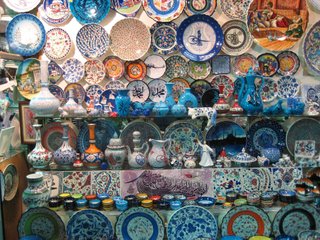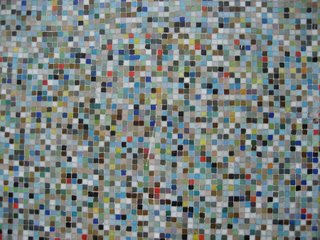

Ceramics wrap seemingly every other building in Istanbul. It is the recognizable form of decoration on many of the great monuments, and is a particular favorite of collectors and tours coming to Turkey. The Blue Mosque (Ahmetiye Cami) is perhaps the high point of the famous Iznik tile period, adorned with the trademark blue and green flower motifs of the 17th century. The interior of the mosque is stunning. Handmade tiles cover seemingly every wall, often in symmetrical arrangements that are unique from bay to bay. They still give the mosque its characteristically bright and sunny feeling; it is hard to believe that many of the tiles are almost 400 years old. Floral motifs in particular became a high art in Ottoman Turkey, since their Sunni form of Islam didn’t allow animal or human form in a place of worship. Tulips, lotuses and roses wrap together in seemingly organic forms that belie rigid geometric and mathematical logic. One can spend an entire afternoon walking the circumference of the interior of the Blue Mosque, soaking in this hybrid of art and science. Even better, you can go down the street to the covered bazaar and buy the “same” tiles for a few dollars. The ceramic business is alive and thriving. You can take home loads of cheap mass produced tiles from the markets, or pick out a plate of the highest quality made, of course, in the authentic tradition. You can even play sultan: order custom designed work from Iznik Foundation over the internet and it will be shipped to your home. Like Bordeaux wine, Parmesan cheese, Kobe beef and other region-based brands, it is often a target of copying by outsiders and fiercely protected by the authentic/original source.



In contrast to this “high” form of ceramics, there is also a more prevalent “low” form (though not yet considered part of the heritage of the city): most post-war apartment buildings are covered in sheets of small ceramic tiles. They are a cheap, durable and easy to clean covering for the hastily constructed buildings, often arranged in motifs and colorful patterns. These buildings, known as yap/sat (literally “build/sell”) are made when a gecekondu land owner who has no money goes into partnership with a local builder who also has limited funds. They will divide the new building in half, each owner taking, say, four of the eight new units. Thus someone who previously owned one unit can now make some additional income without the investment, and a builder will acquire property for the material and labor investment. Much of the city grew this way after the 1950’s. The ubiquitous yap/sat buildings make up a significant portion of the fabric, but also are the first to be targeted for renewal by the government eager to clean up the look and feel of the city. The ceramics that decorate these workmanlike buildings are reminiscent of the Turkish tradition of ornamental tile work. Rolled in sheets, they are combined in different ways on each building, each owner’s personal take on beautification. Since they mostly come from the same limited family of products, the tens of thousands of buildings around the city are linked by their prosaic apartment typology and glowing ceramic tile wrappers.








